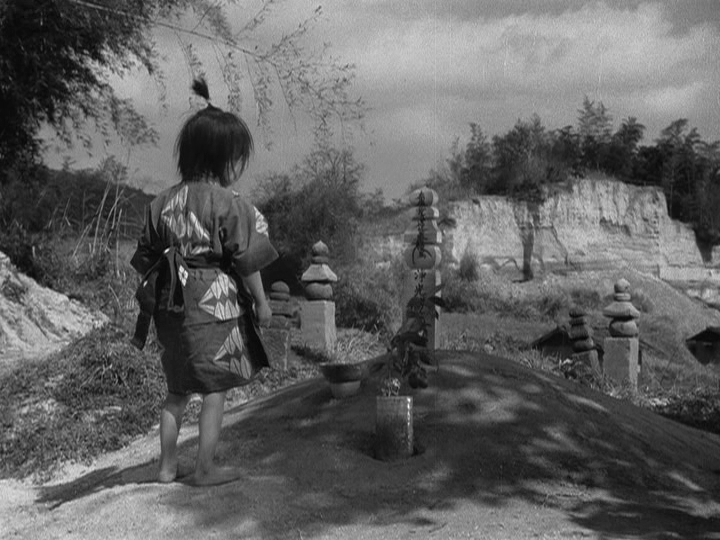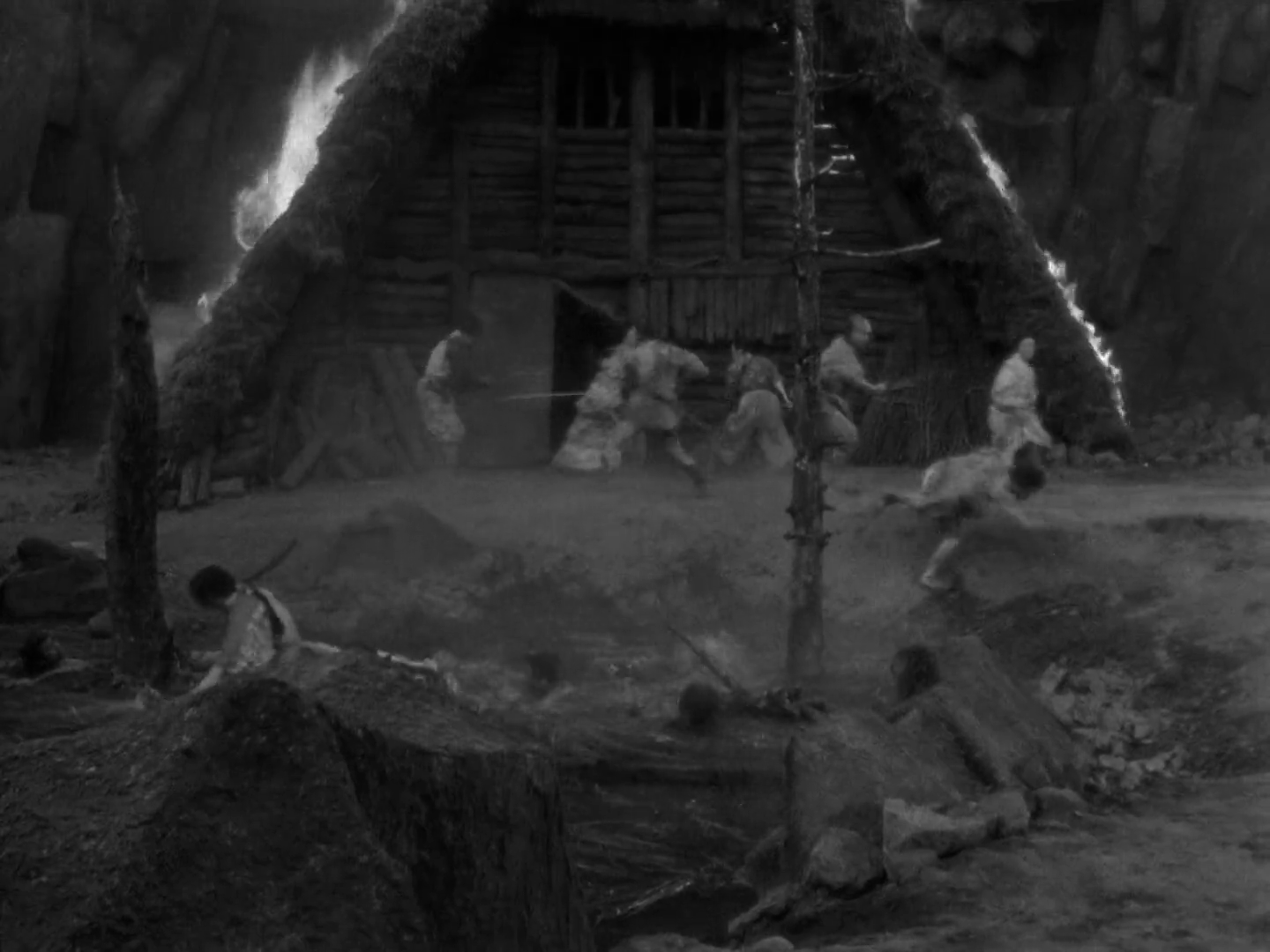Kenzi Mizoguchi’s “Ugetsu Monogatari”,
or “Tales of Moonlight and Rain”, effectively portrays concepts and themes
which are extremely applicable within a universally relatable context, despite
its utilization of a setting that is quite distinctly separated from the
setting occupied currently. The film’s presentation of the difficultly of
balancing individual needs and aspirations with the needs of those one
associates with is bound to be significant within any society. The ability of obsession
with greed and ambition to distort priorities not only occurred during the time
period the film is set, but also when the film was produced as well as in
modern society.
The film takes place in Omi Province
during the 16th century, which was a setting defined by feudalism
and civil war. Thus, it can be considered an effective example of the jidaigeki
genre of film. Because of the lack of stability within communities at the time;
it is difficult for characters in the film to become consistently dependent on
others within those communities. As a result, they are forced to adopt a
certain degree of individualism in order to survive and become successful.

The
film is primarily divided into two stories: one of Genjuro, his wife Miyagi and
their son; and another of Tobei and his wife Ohama. Genjuro works hard to
produce wares in order to provide necessities for his family. Miyagi frequently
attempts to reassure him that she is satisfied by his companionship, and is
less concerned with his generating resources, though Miyagi pays little
attention. As a result, Genjuro seems to unwittingly sacrifice his family’s
security in his greed and obsession, so they are unprepared when their village is
attacked by roaming soldiers. Both families and their wares are unscathed, but
they are forced to travel to a marketplace in another village to sell their
products, and Genjuro and Tobei decide to leave their wives behind, believing
it would be unsafe to bring them.
While selling his pottery, Genjuro
is summoned to the extravagant home of a noblewoman, Lady Wakasa, who is very
appreciative of his craftsmanship and attempts to convince him to stay with
her. Genjuro is humbled by her nobility and easily convinced. He seems to
forget the family he left behind and agrees to marry her. He later encounters and
speaks with a priest, who suggests that he return home and informs him that
Lady Wasaka has departed, and that therefore he must be residing with her
spirit. Genjuro begins to regret his decision, and admits to Lady Wasaka that
he has another family that he has abandoned. She grows angry with him, and
attempts to stop him from leaving. He flees, loses consciousness outside, and
is awoken the next morning by a group of soldiers. Genjuro then sees that her
home has clearly been destroyed long ago. When he returns home, Miyagi is
overjoyed to see him again, and they and their son fall asleep. In the morning,
Genjuro is unable to find Miyagi, and is then told by a neighboring villager
that Miyagi had been killed by soldiers while he was away, and that he had been
caring for their son since then.
Genjuro had been blinded by his lust
for prosperity, and his resulting negligence towards his wife leaves her
abandoned and unprotected, and therefore more susceptible to violence at the
hands of rogue soldiers. Once he finally accepts the warnings of this directed
at him in the beginning of the film and realizes his error, it is too late.

Tobei seeks fame and glory, and
wishes to become a powerful samurai, though both Ohama and Genjuro believe this
to be a foolish goal, and that he should focus on more realistic, domestic
matters. As soon as he receives enough money from the nearby marketplace, he
purchases armor, and attempts to impress and join a group of samurai. Meanwhile,
Ohama is attacked and assaulted by a group of soldiers, and afterwards grows
desperate for subsistence.
Tobei ambushes another soldier who
has taken the head of a general, steals the head, presents to the group of
samurai, and is praised when he convinces them that he killed the general
himself. He becomes respected among the samurai, and when traveling with them
back to his home to show Ohama how successful he has become, they decide to
rest at a brothel. He encounters Ohama there, who has been forced into prostitution
out of desperation. He immediately repents his selfishness. Out of guilt, Tobei
renounces his dreams of becoming a samurai to atone for his misdeed by caring
for and providing for Ohama.
Tobei’s story reflects Genjuro’s in
that both characters were corrupted by their desires and initially ignored the
warnings of others concerning it. Both also eventually realized this and
repented. The fact that they are attracted to completely different objectives
and consider the other’s aspirations less legitimate make the presentation of
this theme within “Ugetsu Monogatari” particularly compelling; because, it
demonstrates that humankind can be corrupted by a wide variety of superficial
desires and that it is always easier to recognize this superficiality in others
than it is to recognize it in oneself.
“Ugetsu Monogatari” was based on a
collection of stories from 1776, and was released in Japan in 1953. Because
Japan was experiencing a period of rebuilding, jidaigeki films depicting a
somewhat deconstructed form of society would have been popular at the time,
such as “Seven Samurai” or “Sansho the Bailiff”. It is entirely conceivable that
while attempting to reconstruct a community, one could become overzealous in
their materialism and experience the same sort of unconscious negligence Genjuro
and Tobei succumbed to. Initially, Genjuro had honest intentions, in that he
wanted to provide and care for his family. However, he was seduced by this
materialism and lost sight of his family as a priority. This could have easily
occurred in the period in Japan the film was developed in, just as it could
easily occur in the hyperactive materialism we experience today.
Throughout “Ugetsu Monogatari”,
Mizoguchi utilizes a rather distinct visual stylization. For instance, many
images are framed at a medium distance, in that they display multiple potential
focal points, but generally not the entire scene in one shot. This is
frequently done by layering or staggering objects within the image, such as by
placing one character in front of another without completely obstructing the
audience’s view of them. As a result he seems to position aspects of the shot
in relation to each other, rather than use an excessive amount of cutting to
portray each aspect individually. Because parts of the scene are related but not
completely visible, the film uses a great deal of camera movement, particularly
horizontal pans.
The film deals primarily with the
domestic relationships of its various characters, so it is very important to
demonstrate how they pertain to one another. Positioning these characters in
relation to each other gives the audience a very strong sense of body language
and chemistry between the characters, which greatly improves how effectively
different emotions are subtly and nonverbally communicated, such as guilt, disappointment
and fear. For example, multiple times throughout the film while two characters
are interacting, one of them will be speaking while the other turns away.
Therefore, the focus of the image is on the character that is speaking rather
than the one that is turned. In order to visually demonstrate the emotional
distance between the two, the camera will rotate around the characters to face
the one that has turned away before they respond, and change the focal point in
doing so.
The scene in which Tobei discovers
Ohama in the brothel makes extensive use of Mizoguchi’s distinctive visual
style. The camera first pans to follow Ohama from left to right as she chases a
man attempting to steal from her and it passes over Tobei when he first notices
the commotion. When Ohama is pushed back from the man, the camera continues to
follow her from right to left, and she and Tobei are brought physically closer
together. When she again advances on the man, the camera and Tobei both follow
her to the right again at the same rate, so although the image itself changes,
Tobei physically remains in the same position in the shot. As he approaches
her, the camera cuts for the first time to Ohama’s left side so that the
audience can see her struggling on the right side of the frame, and Tobei’s
amazed expression as he watches and recognizes her on the left side of the
frame. Ohama recovers her money and shouts proudly at the other man, who is
offscreen. Ohama then becomes the focal point because she is more active, but
Tobei has not moved.
She then turns back, and stops when
she and Tobei are face to face. After a brief hesitation, suggesting that she
also immediately recognizes him, she moves away from him and opposite the
direction of the camera. He follows her as the camera does, so that the camera
remains the same distance from them. She turns to bitterly respond to him,
acknowledging his new status as a samurai. She continues to moves away and then
stops to speak more, then moves away again. Each time Tobei follows her, and
the camera moves with him rather than with her, which suggests that at this
point the audience’s perspective identifies more with Tobei’s amazement. She
exits, and the camera cuts for a second time outside facing them from the opposite
direction, so that they move towards the camera rather than it following them.
Because the cinematography mimics
the physicality of the characters, the audience is able to feel and identify
with the interaction between them. They are able to sense Ohama’s anguish and
emotional distance as she continues to move further and further away, and they
are able to sense Tobei’s remorse and astonishment as he continues to follow
her. All this remains fluid through Mizoguchi’s use of consistent camera
movement rather than sudden cuts.
Overall, “Ugetsu Monogatari”
portrays warnings of potential neglect and obsession caused by excessive
unchecked desire. This is demonstrated thoroughly because of its narrative
presentation of several different forms that obsession can adopt. It is also
communicated effectively through a visual and editing style that reflects
aspects of the narrative. Finally, the audience is extremely likely to connect
with these concepts because of its significant and universal relevance.













